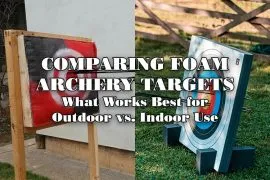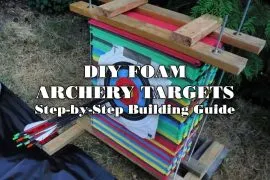Introduction to Foam Archery Targets
Table of Contents
Understanding foam archery target’s construction and material properties is crucial for their care. High-density foam targets are engineered for durability and arrow-stopping power, balancing stiffness, and elasticity to prevent arrow damage and ensure easy arrow removal. The lifespan of these targets can vary significantly based on the foam quality, usage frequency, and maintenance practices.
Strategic Placement and Environmental Considerations
- Avoid Direct Sunlight: Prolonged exposure to UV rays can degrade the foam, causing it to become brittle and lose its elasticity.
- Minimize Moisture Exposure: While some foam is water-resistant, continuous exposure can promote mold growth or internal breakdown. Storing the target off the ground can prevent moisture wicking.
- Temperature Fluctuations: Extreme temperatures can affect the foam’s structure. Avoid placing the target near heat sources or in areas prone to freezing.
Usage and Wear Management
- Even Usage: Regularly rotate and flip the target to ensure arrows impact different areas, promoting even wear and extending its useful life.
- Arrow Considerations: Using appropriate arrows (weight, tip type, and size) can minimize damage. Heavy or improperly tipped arrows can cause unnecessary stress and tears.
- Impact Distribution: Altering shooting distances and angles can help distribute the wear across the target more evenly.
Routine Maintenance and Repairs
- Regular Inspections: Inspect for indications of wear, like profound cuts or regions where the foam has been noticeably compressed. Early detection of damage can inform timely maintenance or adjustments in use.
- Surface Cleaning: Use a soft brush or vacuum to remove dust and debris. If the target needs washing, a damp cloth with mild soap can be used sparingly, ensuring the target is fully dry before storage.
- Repair Techniques: Specific adhesives designed for foam repair can be applied for small tears or cuts. More significant damages may require patching with compatible foam pieces or consulting with the manufacturer for repair kits.
Advanced Care Strategies
- Protective Coatings: Some products allow for a protective spray or coating that can repel water and UV rays, offering additional protection without affecting the foam’s integrity or performance.
- Reinforcement: Use additional materials like duct tape or specialized foam patches to reinforce areas that experience the most wear. This can be particularly effective around the edges or the center, where arrows frequently hit.
- Custom Modifications: Adapting the target with additional layers of foam or creating a modular design can enhance its longevity. This approach allows individual sections to be replaced without discarding the entire target.
Storage and Off-Season Care
- Proper Ventilation: Ensure the storage area is well-ventilated to prevent moisture accumulation. Covers should be breathable to avoid condensation.
- Avoid Compression: Store the target to prevent pressure points or compression, which can deform the foam. Hanging or shelving units can be ideal.
Understanding Foam Target Lifespan
- Realistic Expectations: Recognize that all foam targets have a practical lifespan and will eventually degrade to a point where they no longer perform effectively.
- Replacement vs. Repair: Weigh the cost and effectiveness of repairs against the benefits of purchasing a new target. Sometimes, replacement is more economical and safer than attempting extensive maintenance.
Conclusion
Extending the lifespan of a foam archery target requires a balance of proactive care, strategic use, and regular maintenance. By understanding the material’s properties, implementing protective measures, and addressing wear and damage promptly, archers can ensure their targets remain functional and practical for as long as possible. This comprehensive approach saves money in the long run and supports a sustainable practice by reducing waste. Remember, the goal is to maintain the target’s integrity and safety for all users, ensuring that every practice session is as rewarding as the first.
Faq’s
Q1. How often should I rotate my foam archery target?
Rotate your target regularly, depending on the frequency of use. For daily practice, consider rotating it every session to ensure even wear. If used less frequently, rotating after every few sessions can suffice.
Q2. Can I leave my foam archery target outside permanently?
It’s not recommended to leave your target outside indefinitely. Prolonged exposure to sunlight, rain, and extreme temperatures can degrade the foam. If you must leave it outdoors, use a protective cover and place it in a shaded, dry area.
Q3. When not in use, what is the best way to store my foam target?
Keep your target in a cool, dry location, shielded from direct sunlight and extreme temperatures. Ensure it’s off the ground to avoid moisture absorption, and avoid stacking heavy items on top to prevent compression.
Q4. How can I clean my foam archery target?
Use a soft brush or cloth to gently remove surface debris. For tougher stains, lightly dampen a cloth with water and mild soap. Avoid soaking the foam, as excess moisture can cause damage.
Q5. Can I repair my foam target if it gets damaged?
Minor cuts and holes can be repaired with special foam adhesives. For more extensive damages, consult the manufacturer for repair kits or consider professional repair services.
Q6. Can using different arrow types affect the lifespan of my target?
Yes, using arrows that are too heavy or improper tips for your target’s density can cause excessive wear or damage. Always match your arrow type to the target’s specifications.
Q7. What signs indicate that my foam target needs to be replaced?
Look for signs of significant wear, such as deep holes that don’t self-heal, areas where the foam has become compacted and complex, or if the target no longer stops arrows effectively.
Q8. How can I protect my target from weather damage?
Use a weather-resistant cover when the target is not in use. Consider a cover specifically designed to repel water and protect against UV damage.
Q9. Can I apply any products to the target to extend its lifespan?
Some products can provide UV protection or water repellency without harming the foam’s integrity. Always check the product compatibility with your target material and consult the manufacturer if unsure.
Q10. Should I use a backstop with my foam target, and can it help extend the target’s lifespan?
Yes, using a backstop behind your target can significantly reduce wear by catching any arrows that miss or pass through the target. This extends the life of your target and enhances safety during practice.








